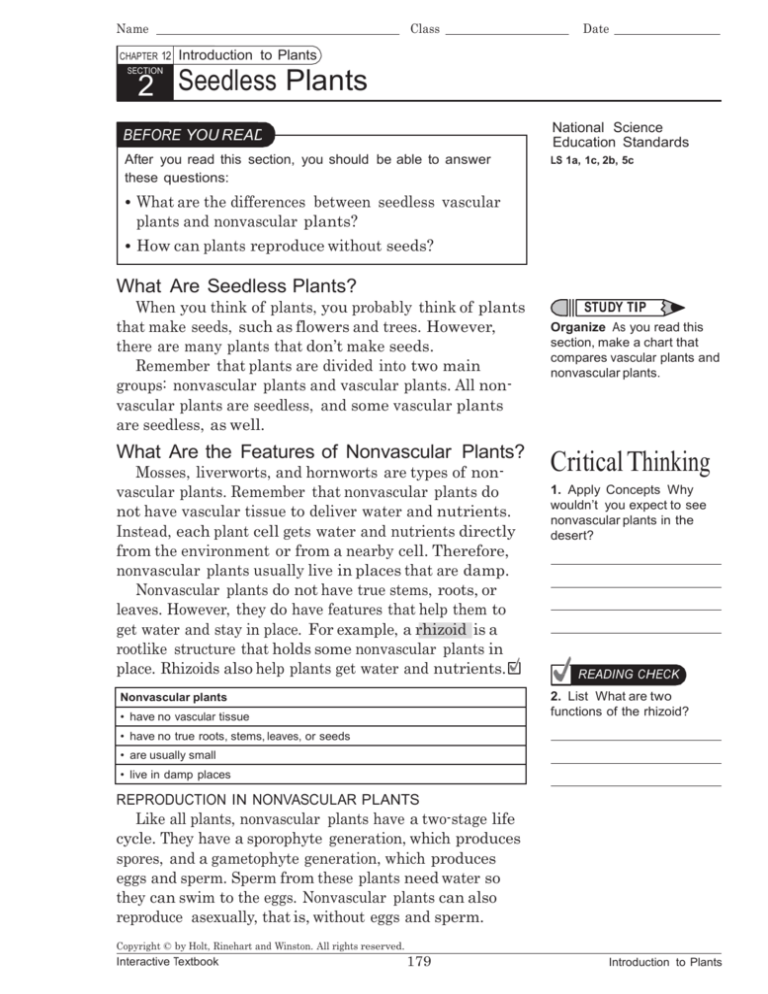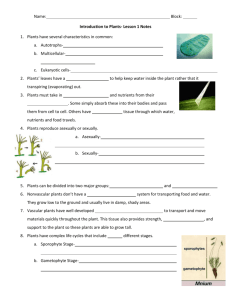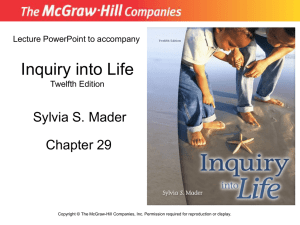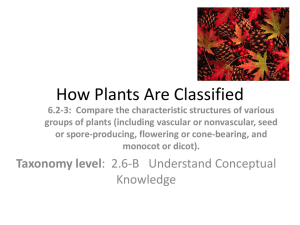
Name
CHAPTER 12
Class
Date
Introduction to Plants
SECTION
2 Seedless Plants
National Science
Education Standards
BEFORE YOU READ
After you read this section, you should be able to answer
these questions:
LS 1a, 1c, 2b, 5c
• What are the differences between seedless vascular
plants and nonvascular plants?
• How can plants reproduce without seeds?
What Are Seedless Plants?
When you think of plants, you probably think of plants
that make seeds, such as flowers and trees. However,
there are many plants that don’t make seeds.
Remember that plants are divided into two main
groups: nonvascular plants and vascular plants. All nonvascular plants are seedless, and some vascular plants
are seedless, as well.
What Are the Features of Nonvascular Plants?
Mosses, liverworts, and hornworts are types of nonvascular plants. Remember that nonvascular plants do
not have vascular tissue to deliver water and nutrients.
Instead, each plant cell gets water and nutrients directly
from the environment or from a nearby cell. Therefore,
nonvascular plants usually live in places that are damp.
Nonvascular plants do not have true stems, roots, or
leaves. However, they do have features that help them to
get water and stay in place. For example, a rhizoid is a
rootlike structure that holds some nonvascular plants in
place. Rhizoids also help plants get water and nutrients.
STUDY TIP
Organize As you read this
section, make a chart that
compares vascular plants and
nonvascular plants.
Critical Thinking
1. Apply Concepts Why
wouldn’t you expect to see
nonvascular plants in the
desert?
READING CHECK
2. List What are two
functions of the rhizoid?
Nonvascular plants
• have no vascular tissue
• have no true roots, stems, leaves, or seeds
• are usually small
• live in damp places
REPRODUCTION IN NONVASCULAR PLANTS
Like all plants, nonvascular plants have a two-stage life
cycle. They have a sporophyte generation, which produces
spores, and a gametophyte generation, which produces
eggs and sperm. Sperm from these plants need water so
they can swim to the eggs. Nonvascular plants can also
reproduce asexually, that is, without eggs and sperm.
Copyright © by Holt, Rinehart and Winston. All rights reserved.
Interactive Textbook
179
Introduction to Plants
Name
SECTION 2
Class
Date
Seedless Plants continued
c Spores land in a moist
Moss Life Cycle
place, crack open, and grow
into leafy gametophytes.
b The sporophyte
releases spores
into the air.
Gametophyte
Spores
Sporophyte
Male
a The fertilized egg grows into
TAKE A LOOK
3. Identify Are the male
and female gametophytes
separate plants or part of the
same plant?
a sporophyte. The sporophyte grows from the
top of the gametophyte.
Female
Gametophyte
Egg
Sporophyte
Fertilized egg
Sperm
d Sperm swim through water
from the male gametophyte
to fertilize the egg at the top
of the female gametophyte.
IMPORTANCE OF NONVASCULAR PLANTS
Critical Thinking
4. Apply Concepts Why do
you think nonvascular plants
can be the first plants to
grow in a new environment?
Nonvascular plants are usually the first plants to live in
a new environment, such as newly exposed rock. When
these plants die, they break down and help form a thin
layer of soil. Then plants that need soil in order to grow
can move into these areas.
Some nonvascular plants are important as food or
nesting material for animals. A nonvascular plant called
peat moss is important to humans. When it turns to peat,
it can be burned as a fuel.
What Are the Features of Seedless
Vascular Plants?
READING CHECK
5. Explain How do the cells
of a seedless vascular plant
get water?
Vascular plants have specialized tissues that carry water
and nutrients to all their cells. These tissues generally
make seedless vascular plants larger than nonvascular
plants. Because they have tissues to move water, vascular
plants do not have to live in places that are damp.
Many seedless vascular plants, such as ferns, have
a structure called a rhizome. The rhizome is an underground stem that produces new leaves and roots.
2HIZOME
Copyright © by Holt, Rinehart and Winston. All rights reserved.
Interactive Textbook
180
Introduction to Plants
Name
SECTION 2
Class
Date
Seedless Plants continued
REPRODUCTION IN SEEDLESS VASCULAR PLANTS
The life cycles of vascular plants and nonnvascular
plants are similar. Sperm and eggs are produced in gametophytes. They join to form a sporophyte. The sporophyte
produces spores. The spores are released. They grow into
new gametophytes.
Seedless vascular plants can also reproduce asexually in
two ways. New plants can branch off from older plants.
Pieces of a plant can fall off and begin to grow as new plants.
READING CHECK
6. Identify What do spores
grow into?
Fern Life Cycle
c Spores land on moist
Gametophyte
soil and grow into
gametophytes.
Spores
TAKE A LOOK
Sperm
Egg
Female
Male
d A sperm swims
through water to
fertilize an egg.
7. Apply Concepts Does this
figure show sexual or asexual
reproduction? Explain your
answer.
b The sporophyte
releases spores
into the air.
Fertilized egg
Sporophyte
a The fertilized egg grows
into a sporophyte.
IMPORTANCE OF SEEDLESS VASCULAR PLANTS
Did you know that seedless vascular plants that lived
300 million years ago are important to people today?
After these ancient ferns, horsetails, and club mosses
died, they formed coal and oil. Coal and oil are fossil
fuels that people remove from Earth’s crust to use for
energy. They are called fossil fuels because they formed
from plants (or animals) that lived long ago.
Another way seedless vascular plants are important is
they help make and preserve soil. Seedless vascular
plants help form new soil when they die and break down.
Their roots can make the soil deeper, which allows other
plants to grow. Their roots also help prevent soil from
washing away.
Many seedless vascular plants are used by humans. Ferns
and some club mosses are popular houseplants. Horsetails
are used in some shampoos and skincare products.
READING CHECK
8. Explain Where does coal
come from?
Copyright © by Holt, Rinehart and Winston. All rights reserved.
Interactive Textbook
181
Introduction to Plants
Name
Class
Section 2 Review
Date
NSES
LS 1a, 1c, 2b, 5c
SECTION VOCABULARY
rhizoid a rootlike structure in nonvascular plants
that holds the plants in place and helps plants
get water and nutrients
rhizome a horizontal underground stem that
produces new leaves, shoots, and roots
1. Compare What are two differences between a rhizoid and a rhizome?
2. Explain In which generation does sexual reproduction occur? Explain your answer.
3. Compare Use a Venn Diagram to compare vascular and nonvascular plants.
4. Describe What are two ways in which seedless nonvascular plants reproduce
asexually?
5. Apply Concepts Nonvascular plants are usually very small. How does their struc-
ture limit their size?
Copyright © by Holt, Rinehart and Winston. All rights reserved.
Interactive Textbook
182
Introduction to Plants








